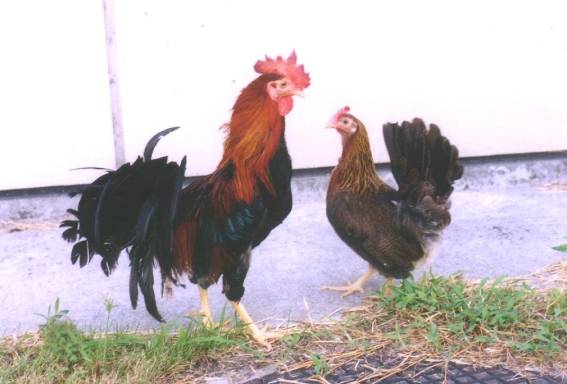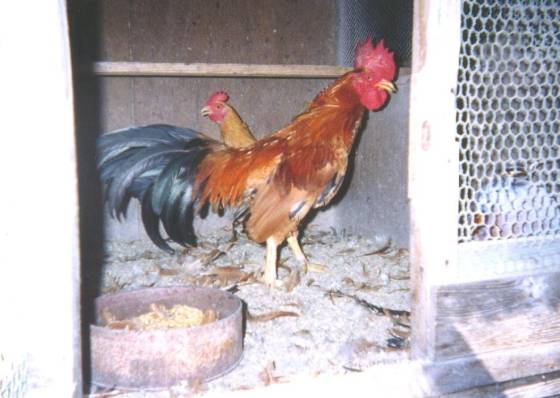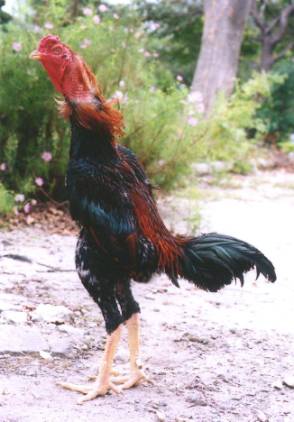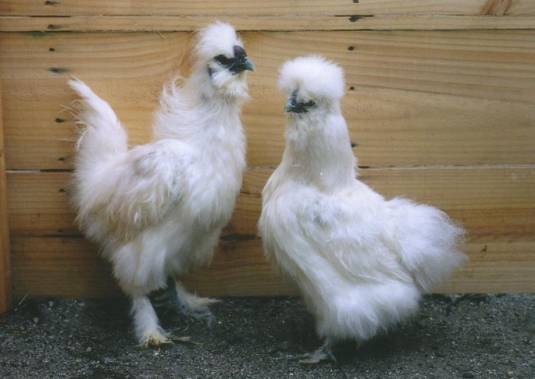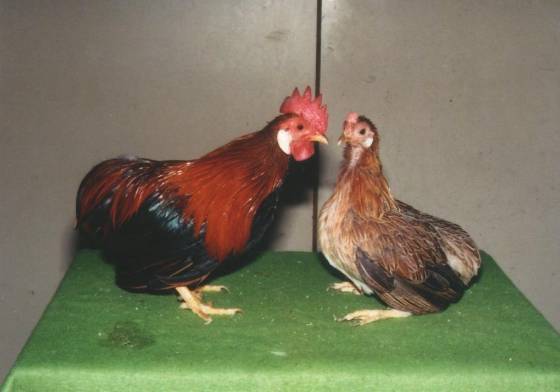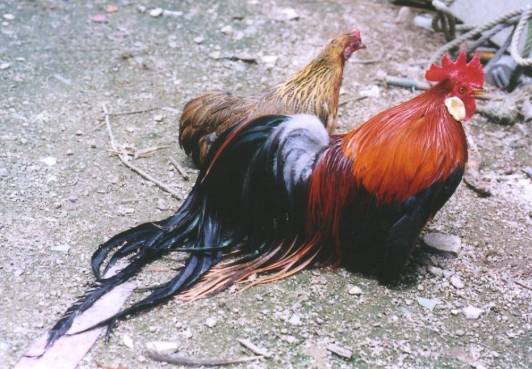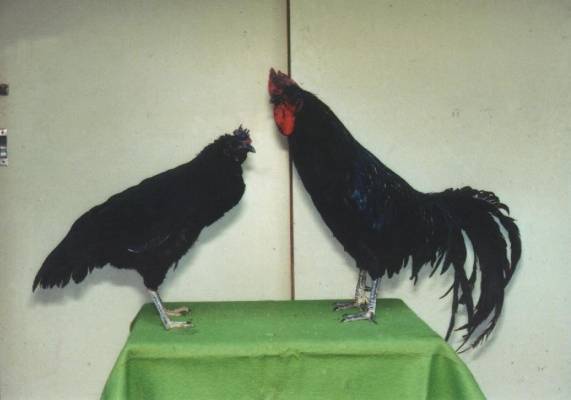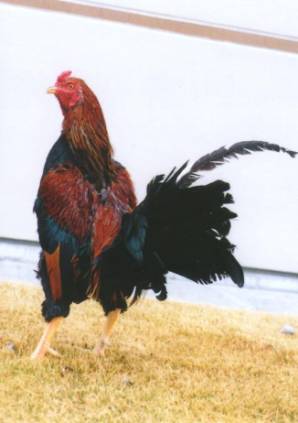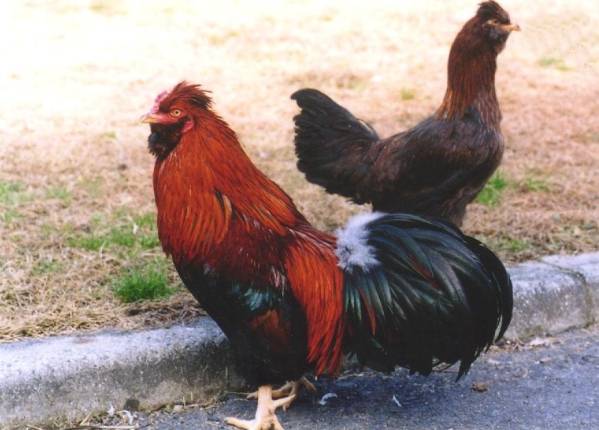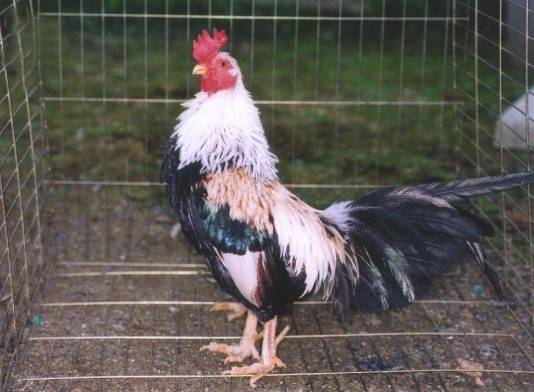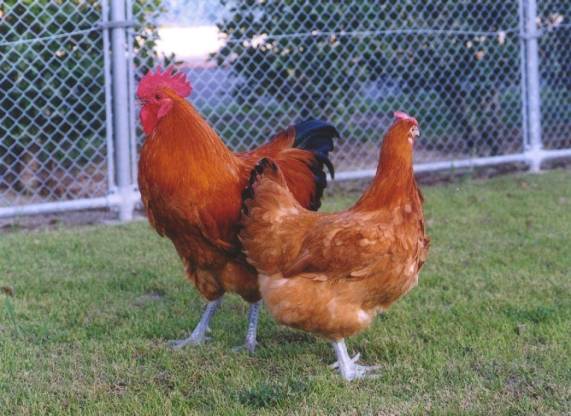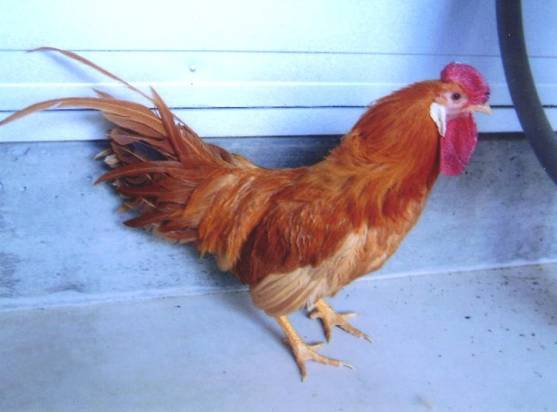
此文件來自 台灣畜產種原知識庫
https://agrkb.angrin.tlri.gov.tw
Japanese Native Chickens
Masaoki Tsudzuki
Laboratory of Animal Breeding and Genetics, Graduate School of Biosphere Science, Hiroshima University, Higashi-Hiroshima, Hiroshima 739-8528, Japan
Introduction
There are approximately 50 breeds of native chickens in Japan (Table 1). Japanese native chickens are classified into 2 groups. The first group is those for hobbyists. The second group is for egg and/or meat production. The former group will be called “Japanese fancy fowl” and the latter “Japanese utility fowl” in this article. Japanese fancy fowl are further classified into 2 subgroups. The first subgroup includes chickens introduced to Japan more than 2,000 years ago. The second subgroup includes chickens introduced to Japan later. The former is called “Jidori (Japanese Old Type)”. Among the latter, the Shoukoku (Japanese Elegancy) breed was introduced to Japan during the Heian Era (794 – 1192). The Oh-Shamo (Japanese Large Game), Chabo (Japanese Bantam), and Ukokkei (Japanese Silkie) breeds were introduced during the early Edo Era (1603 – 1867). Other Japanese fancy breeds were established by the end of the Edo Era via mating these foreign derived chickens with Jidori and followed by selective propagation.
The Japanese Government has designated many Japanese fancy fowl as “Natural Monuments of Japan”. They are Jidori (Japanese Old Type), Shoukoku (Japanese Elegancy), Shamo (Japanese Game), Chabo (Japanese Bantam), Ukokkei (Japanese Silkie), Uzurao (Japanese Small Rumplessness), Tosa-Onagadori (Japanese Long Tail), Ohiki (Japanese Tail Dragger), Toutenkou (Japanese Red Crower), Koeyoshi (Japanese Good Crower), Toumaru (Japanese Black Crower), Kuro-Kashiwa (Japanese Black), Satsuma-Dori (Kagoshima Game), Hinai-Dori (Japanese Dainty), Minohiki (Japanese Saddle Hackle Dragger), Jitokko (Japanese Creeper), and Kawachi-Yakko (Japanese Brave). Among them, the Tosa-Onagadori was designated as “Special Natural Monument of Japan”.
The Jidori classification includes three or more breeds. The three major Jidori breeds are the Tosa-Kojidori (Japanese Old Type-Tosa), Gifu-Jidori (Japanese Old Type-Gifu), and Mie-Jidori (Japanese Old Type-Mie). The Shamo classification actually involves seven breeds: Oh-Shamo (Japanese Large Game), Ko-Shamo (Japanese Small Game), Yamato-Gunkei (Yamato Game), Yakido (Mie Game), Kinpa (Japanese Henny Feathered Game), Nankin-Shamo (Japanese Slender Game), and Echigo-Nankin-Shamo (Niigata Slender Game).
The majority of the Japanese utility breeds were established during the Meiji Era (1868 – 1912). Although these breeds were originally used for egg production and/or meat production, from the Meiji Era to the early Shouwa Era (1926 – 1989), the number of utility chickens is actually very small in present Japan. People mostly rear them to enjoy their beautiful figure.
The following is the brief description of the features of the main Japanese native chicken breeds.
Japanese fancy fowl
Tosa-Kojidori [Japanese Old Type-Tosa (Fig. 1), Natural Monument designated in 1941]
This breed is one of the oldest breeds in Japan and is the smallest breed among the Japanese native chickens. The ancestor of this breed is thought introduced to Japan more than 2,000 years ago. The body shape and plumage color of this breed are similar to the Red Jungle Fowl (RJF). However, the brown neck and saddle hackles of the male are heavier in color than those in the RJF.
The prefecture of origin: Kochi Prefecture
Standard body weight (BW) in adults: 675 g in male, 600 g in female
Plumage color varieties: black-breasted red, white
Comb: single
Earlobe color:red
Gifu-Jidori [Japanese Old Type-Gifu (Fig. 2), Natural Monument designated in 1941]
This is also one of the oldest breeds in Japan. The ancestor of this breed is thought introduced into Japan more than 2,000 years ago. The body size of this breed is larger than that of the Tosa-Kojidori. The body shape shows the RJF type. The plumage color is similar to the RJF, that is, the brown neck and saddle hackles in the males are more yellow than those in the Tosa-Kojidori.
The prefecture of origin: Gifu Prefecture
Standard BW in adults: 1,800 g in male, 1,350 g in female
Plumage color varieties: black-breasted red (e+/e+ or ey/ey)
Comb: single
Earlobe color:red
Shank color:yellow
Mie-Jidori [Japanese Old Type-Mie (Fig. 3), Natural Monument designated in 1941]
This is also one of the oldest breeds in Japan. The ancestor of this breed is thought introduced into Japan more than 2,000 years ago. The body shape shows the RJF type like the Tosa-Kojidori and Gifu-Jidori, but its plumage color is different.
The prefecture of origin: Mie Prefecture
Standard BW in adults: 1,800 g in male, 1,350 g in female
Plumage color varieties: buff columbian
Comb: single
Earlobe color:red
Shank color:yellow
Shoukoku [Japanese Elegancy (Fig. 4), Natural Monument designated in 1941]
The ancestor of this breed was introduced to Japan during the Heian Era (794 – 1192) from China. The Shoukoku is a graceful breed with long (more than 1 m) tail feathers and long saddle hackles. The body shape shows the RJF type, but the arrangement and amount of tail feathers are different from the RJF type. During the Heian Era, this breed was used for cock fighting. Today it is used only for enjoying its beautiful color and figure.
Main habitat: Kyoto Prefecture, Mie Prefecture, Shiga Prefecture
Standard BW in adults: 2,000 g in male, 1,600 g in female
Plumage color varieties: black-breasted white (silver duckwing), black-breasted white with brown wing coverts, white
Comb: single
Earlobe color:red
Shank color:yellow
Oh-Shamo [Japanese Large Game (Fig. 5), Natural Monument designated in 1941]
The ancestor of this breed was introduced into Japan during the early Edo Era (1603 – 1867) from Thailand. There is also another view that the ancestor of this breed was introduced to Japan during the Heian Era (794 – 1192). The Oh-Shamo is a large chicken with a Malay-type body shape; that is, the body (the line from the shank, breast to throat) is erect. The feathers are tightly attached to the body and the tail feathers are short. There are no feathers around the keel and thus red skin is easily visible in this region. The Oh-Shamo was originally a breed for cock fighting. This breed has a large amount of good quality meat. The Oh-Shamo is often used as a sire to improve meat-type chickens in Japan.
Main habitat: Tokyo, Ibaraki Prefecture, Chiba Prefecture, Aomori prefecture, Akita Prefecture, Kochi Prefecture
Standard BW in adults: 5,620 g in male, 4,875 g in female
Plumage color varieties: black-breasted red, black, white, mottled, blue, silver duckwing, buff columbian
Comb: pea
Earlobe color:red
Shank color:yellow
Chabo [Japanese Bantam (Fig. 6), Natural Monument designated in 1941]
This is a small breed, next to the Tosa-Kojidori in size. The body shape does not correspond to any of the RJF, Malay, or Cochin types. The tail feathers do not curve and are erect. The ancestor of this breed was introduced to Japan in the early Edo Era (1603 - 1867). This breed has short shanks. It is thought that the short shank is not controlled by the Cp gene. The genetic details for the short shank are unknown at present.
Main habitat: Tokyo, Chiba Prefecture, Kanagawa Prefecture, Saitama Prefecture, Gunma Prefecture, Shizuoka Prefecture, Osaka Prefecture, Kumamoto Prefecture
Standard BW in adults: 730 g in male, 610 g in female
Plumage color varieties: white columbian, white, black, buff, buff columbian, black-breasted red, silver duckwing, silver gray, barred, blue, pile, and many others
Comb: single
Earlobe color:red
Shank color:yellow
Ukokkei [Japanese Silkie (Fig. 7), Natural Monument designated in 1941]
This breed is a strange breed having numerous mutant characteristics. The Ukokkei has no normal feathers on its’ body. The feathers of this breed do not have a flat web. The feathers have abnormal barbules and no barbicels, resulting in a silky appearance. The skin is blackish and the earlobes are blue. The surface of the bones and viscera are blackish. It has a comb and crest on the head. Some birds show a bone rising at the top of the skull. In addition to the crest, some birds have a muff and beard. The Ukokkei has feathered shanks and five digits per leg. The ancestor of this breed was introduced to Japan in the early Edo Era (1603 – 1867) from China or India.
Main habitat: Tokyo, Mie Prefecture, Osaka Prefecture, Hiroshima Prefecture, Yamaguchi Prefecture, Kagawa Prefecture
Standard BW in adults: 1,125 g in male, 900 g in female
Plumage color varieties: white, black
Comb: both walnut and crest
Earlobe color:blue
Shank color:lead-gray
Uzurao [Japanese Small Rumplessness (Fig. 8), Natural Monument designated in 1937]
This is a small breed similar to the Tosa-Kojidori, except for its tail morphology and earlobe color. This breed has white earlobes and lacks tail feathers. This breed is thought established in the late stages of the Edo Era (1603 – 1867).
The prefecture of origin: Kochi Prefecture
Standard BW in adults: 675 g in male, 600 g in female
Plumage color varieties: black-breasted red, white, mottled, and many others
Comb: single
Earlobe color:white
Shank color:yellow
Tosa-Onagadori [Japanese Long Tail (Fig. 9), Natural Monument designated in 1923, Special Natural Monument designated in 1952]
This is a peculiar breed. The basic body shape of this breed is the RJF type. However, the males have very long tail feathers more than 10 m in the longest case. Some tail feathers and all of the saddle hackles in the males show no molting throughout their lives. The tail feathers successively extend at the pace of 70 to 100 cm per year, with the saddle hackles about 30 cm per year. This breed is thought established in the late Edo Era (1603 – 1867).
The prefecture of origin: Kochi Prefecture
Standard BW in adults: 1,800 g in male, 1,350 g in female
Plumage color varieties: black-breasted white (Silver duckwing), black-breasted red, white, buff columbian
Comb: single
Earlobe color:white
Shank color:grayish green
Ohiki [Japanese Tail Dragger (Fig. 10), Natural Monument designated in 1937]
This breed has a small body size somewhat larger than the Chabo. In spite of the small body size, the males have considerably long (70 – 80 cm) tail feathers. The saddle hackles are also long. These feathers molt, unlike the case of the Tosa-Onagadori. This breed is thought established in the late stages of the Edo Era (1603 – 1867).
The prefecture of origin: Kochi Prefecture
Standard BW in adults: 937 g in male, 750 g in female
Plumage color varieties: black-breasted red, black-breasted white, white
Comb: single
Earlobe color:white
Shank color:grayish green
Toutenkou [Japanese Red Crower (Fig. 11), Natural Monument designated in 1936]
This breed is characterized by long (around 15 seconds) crowing in a high-pitched tone. The body shape of this breed resembles that of the Shoukoku breed. The tail feathers and saddle hackles are also rich and long like the Shoukoku. However, the plumage, earlobes, and shank colors are different. The Toutenkou is thought established in the late Edo Era (1603 – 1867).
The prefecture of origin: Kochi Prefecture
Standard BW in adults: 2,250 g in male, 1,800 g in female
Plumage color varieties: black-breasted red
Comb: single
Earlobe color:white
Shank color:grayish green
Koeyoshi [Japanese Good Crower (Fig. 12), Natural Monument designated in 1937]
This breed is similar to the Oh-Shamo in body shape with richer body feathers and longer tail feathers. This breed is characterized by long (around 15 seconds) crowing as with the Toutenkou. However, this breed crows in a low key. This breed is thought established in the late stages of the Edo Era (1603 – 1867). Judging from the external appearance, this breed seems to have been affected by genes from the Oh-Shamo.
Main habitat: Akita Prefecture, Aomori Prefecture, Iwate Prefecture
Standard BW in adults: 4,500 g in male, 3,750 g in female
Plumage color varieties: black-breasted white with brown wing coverts
Comb: pea
Earlobe color:red
Shank color:yellow
Toumaru [Japanese Black Crower (Fig. 13), Natural Monument designated in 1939]
The Toumaru is a black fowl with an RJF-type body shape and rich tail feathers. The saddle hackles are not long. The comb, face, and wattle are blackish red in the females. Cock crows around 15 seconds in average and thus classified as a long duration crow as the Toutenkou and Koeyoshi. The Toumaru males crow in an intermediate-pitched tone between the Toutenkou and Koeyoshi. The Toutenkou, Koeyoshi, and Toumaru are “the three major Japanese long crowing breeds”. The Toumaru is thought established in the early Meiji Era (1868 – 1912).
The prefecture of origin: Niigata Prefecture
Standard BW in adults: 3,750 g in male, 2,800 g in female
Plumage color varieties: black, white
Comb: single
Earlobe color:red or blackish red in male, blackish red in female
Shank color:black
Kuro-Kashiwa [Japanese Black (Fig. 14), Natural Monument designated in 1940]
This breed looks similar to the Toumaru at first glance because the Kuro-Kashiwa is also a black chicken with rich tail feathers. Both sexes have a blackish red comb, face and wattles. However, the body size of the Kuro-Kashiwa is smaller than the Toumaru. The body shape is similar to that of the Shoukoku, but the saddle hackles are not long. This breed is thought established in the late Edo Era (1603 – 1867). Although the appearance of the Kuro-Kashiwa is similar to that of Toumaru, the Kuro-Kashiwa has no direct genetic relation to the Toumaru.
Main habitat: Shimane Prefecture, Yamaguchi Prefecture
Standard BW in adults: 2,800 g in male, 1,800 g in female
Plumage color varieties: black
Comb: single
Earlobe color:blackish red
Shank color:black
Satsuma-Dori [Kagoshima Game (Fig. 15), Natural Monument designated in 1943]
This breed has a somewhat erect body shape like the Oh-Shamo. However, it has more abundant feathers than the Oh-Shamo. The tail feathers in the males are rich and fan out when the male is excited. This chicken was originally bred for cock fighting. A small sword was attached to the leg around the spur. Cock fighting of this kind is prohibited in present Japan. People now rear this breed to enjoy its beautiful figure. The Satsuma-Dori is thought established in the late Edo Era (1603 – 1867). One of its ancestors seems to be the Oh-Shamo, since the head morphology and erect body shape of this breed are similar to the Oh-Shamo.
The prefecture of origin: Kagoshima Prefecture
Standard BW in adults: 3,375 g in male, 2,625 g in female
Plumage color varieties: black-breasted red, black-breasted white, black, white
Earlobe color:red
Shank color:yellow
Standard BW in adults: 3,000 g in male, 2,300 g in female
Standard BW in adults: 2,500 g in male, 1,800 g in female
Standard BW in adults: 3,000 g in male, 2,500 g in female
Standard BW in adults: 930 g in male, 750 g in female
Japanese utility fowl
Nagoya (Fig. 20)
This breed was established in Aichi Prefecture during the Taishou Era (1912 – 1926) by removing the leg feathers from the Nagoya Cochin. The Nagoya Cochin was established during the Meiji Era (1868 – 1912) by crossing the Cochin, whose origin is in China, and some Japanese native breed. Today, the Nagoya Cochin is extinct. The Nagoya breed has a Cochin-type body shape with buff columbian colored plumage. The buff color of this breed has an orange tinge. Until White Leghorn and broiler chickens were introduced to Japan on a large scale from the U.S.A., this breed was used to produce eggs and meat. However, after the introduction of American utility breeds, people have reared the Nagoya only to enjoy its beautiful figure. This breed was again used for egg and meat production in Japan on a small scale, because the Japanese recognized that this breed produces more delicious meat and eggs than the American utility breeds. The other features of Nagoya are a single comb, red earlobes and lead-gray shanks.
Tosa-Kukin (Fig. 21)
The Japanese word “Kukin” means Cochin. This breed was established in Kochi Prefecture during the Meiji Era (1868 – 1912) by crossing the Cochin and some Japanese native breed. The body size and shape are very similar to the Nagoya mentioned above. The plumage color is buff columbian like the Nagoya breed. The buff color of this breed is true buff and the tail feathers are brownish, differing from the Nagoya, which is an Orange buff color with black tail feathers. The Tosa-Kukin was originally used for egg and meat production. However, the number of Tosa-Kukin is very small. People now rear this breed to enjoy its figure. The other features included a single comb, red earlobes and yellow shanks.
Mikawa (Fig. 22)
This breed was established in Aichi Prefecture during the Meiji Era (1868 – 1912) for egg production. Although the breed was established in Japan, no Japanese native breeds contributed to its establishment. Some foreign breeds were crossed in Japan to make this breed. This breed has an RJF-type body shape with buff colored plumage. Similar to the Tosa-Kukin, the number of this bird is very small currently in Japan. This bird has a single comb, white earlobes and yellow shanks.
Conclusion
In the past, Japanese fancy chicken breeds were not used for egg and meat production. However, they have good quality eggs and meat. The author thinks that Japanese fancy chicken breeds are valuable genetic resources for improving commercial chickens. In Japan, new meat-type chickens have been produced in every Prefectural Livestock Research Institute by mating Japanese fancy fowl (e.g., Oh-Shamo, Satsuma-Dori, and Hinai-Dori) to American breeds (e.g., White Plymouth Rock, Barred Plymouth Rock, and Rhode Island Red) to produce more delicious meat than commercial broilers (F1 hybrid between White Cornish and White Plymouth Rock) meat.
The author is now performing quantitative trait loci (QTL) analyses to reveal useful genes controlling meat and egg quality. When this analysis is completed, we will be able to efficiently produce new useful chicken lines or breeds based on Marker Assisted Selection.
In addition to the QTL analyses, the author is performing a phylogenetic study on Japanese native chickens using microsattelite DNA polymorphisms. When this study is completed, the genetic relationship between Japanese native breeds will be precisely revealed.
|
Japanese name |
English name |
The prefecture of origin or main habitat |
Fancy fowl |
||
|
Aizu-Jidori* |
Fukushima Pref. |
|
|
Chabo |
Japanese Bantam |
Tokyo, Chiba Pref., Kanagawa Pref., Saitama Pref., Gunma Pref., Shizuoka Pref., Osaka Pref. |
|
Daigiri-Shamo |
Single Combed Large Game |
Yamaguchi Pref. |
|
Echigo-Nankin-Shamo |
Niigata Slender Game |
Niigata Pref. |
|
Ehime-Jidori* |
Japanese Old Type-Ehime |
Ehime Pref. |
|
Gan-Dori |
Aomori Creeper |
Aomori Pref. |
|
Gifu-Jidori |
Japanese Old Type - Gifu |
Gifu Pref. |
|
Hinai-Dori |
Japanese Dainty |
Akita Pref. |
|
Hiroshima-Tsuuji |
Hiroshima Game |
Hiroshima Pref. |
|
Ingie |
Kagoshima Large Rumplessness |
Kagoshima Pref. |
|
Iwate-Jidori* |
Japanese Old Type-Iwate |
Iwate Pref. |
|
Jisuri |
Short Legged Large Game |
Kumamoto Pref. |
|
Jitokko |
Japanese Creeper |
Kagoshima Pref., Miyazaki Pref. |
|
Kawachi-Yakko |
Japanese Brave |
Mie Pref. |
|
Kinpa |
Japanese Henny Feathered Game |
Akita Pref., Aomori Pref. |
|
Koeyoshi |
Japanese Good Crower |
Akita Pref., Aomori Pref., Iwate Pref. |
|
Ko-Shamo |
Japanese Small Game |
Tokyo, Kanagawa Pref., Niigata Pref., Shizuoka Pref., Kochi Pref. |
|
Kureko-Dori |
Kumamoto Long Tail |
Kumamoto Pref. |
|
Kuro-Kashiwa |
Japanese Black |
Yamaguchi Pref., Shimane Pref. |
|
Mie-Jidori |
Japanese Old Type ─Mie |
Mie Pref. |
|
Minohiki |
Japanese Saddle Hackle Dragger |
Aichi Pref., Shizuoka Pref. |
|
Miyaji-Dori |
Kochi Creeper |
Kochi Pref. |
|
Nankin-Shamo |
Japanese Slender Game |
Ibaraki Pref., Chiba Pref. |
|
Ohiki |
Japanese Tail Dragger |
Kochi Pref. |
|
Oh-Shamo |
Japanese Large Game |
Tokyo, Ibaraki Pref., Chiba Pref., Aomori Pref., Akita Pref., Kochi Pref. |
|
Okinawa-Hige-Jidori* |
Okinawa Old Type ─bearded |
Okinawa Pref. |
|
Sado-Hige-Jidori* |
Japanese Old Type ─Niigata bearded |
Niigata Pref. |
|
Satsuma-Dori |
Kagoshima Game |
Kagoshima Pref. |
|
Shibattori |
Japanese Old Type ─Niigata |
Niigata Pref. |
|
Shoukoku |
Japanese Elegancy |
Kyoto Pref., Mie Pref., Shiga Pref. |
|
Tokara-Jidori* |
Japanese Old Type ─ Tokara |
Kagoshima Pref. |
|
Tokuji-Jidori* |
Japanese Old Type ─ Tokuji |
Yamaguchi Pref. |
|
Tosa-Kojidori |
Japanese Old Type ─Tosa |
Kochi Pref. |
|
Tosa-Onagadori |
Japanese Long Tail |
Kochi Pref. |
|
Toumaru |
Japanese Black Crower |
Niigata Pref. |
|
Toutenkou |
Japanese Red Crower |
Kochi Pref. |
|
Tsushima-Jidori* |
Tsushima Old Type |
Nagasaki Pref. |
|
Ukokkei |
Japanese Silkie |
Tokyo, Mie Pref., Osaka Pref., Hiroshima Pref., Yamaguchi Pref., Kagawa Pref. |
|
Utaicharn |
Okinawa Crower |
Okinawa Pref. |
|
Uzurao |
Japanese Small Rumplessness |
Kochi Pref. |
|
Yakido |
Mie Game |
Mie Pref. |
|
Yamato-Shamo |
Yamato Game |
Tokyo, Saitama Pref., Fukuoka Pref. |
Utility fowl |
||
|
Izumo |
─ |
Shimane Pref. |
|
Kumamoto |
─ |
Kumamoto Pref. |
|
Mikawa |
─ |
Aichi Pref. |
|
Nagoya |
─ |
Aichi Pref. |
|
─ |
Kochi Pref. |
|
*There is no evidence that these breeds are real "Jidori (Old Type)", but they are generally called "Jidori". Further studies are necessary in the future to elucidate whether these are real "Jidori".
|
|
|
|
|
Fig. 1. Tosa-Kojidori (Japanese Old Type-Tosa), black-breasted red Left: male, Right: female |
|
|
|
|
|
|
|
|
|
|
|
Fig. 2. Gifu-Jidori (Japanese Old Type-Gifu), black-breasted red Left: male, Right: female |
|
|
|
|
|
|
|
Fig. 3. Mie-Jidori (Japanese Old Type-Mie) cock, buff columbian |
|
|
|
|
|
|
|
|
|
|
|
Fig. 4. Shoukoku (Japanese Elegancy) cock, black-breasted white with brown wing coverts |
|
|
|
|
|
|
|
Fig. 5. Oh-Shamo (Japanese Large Game) cock, black-breasted red |
|
|
|
|
|
|
|
|
|
|
|
Fig. 6. Chabo (Japanese Bantam) cock, white columbian (black-tailed white) The tail feathers are shorter than in the normal condition due to molting. |
|
|
|
|
||
|
Fig. 7. Ukokkei (Japanese Silkie), white Left: male, Right: female |
||
|
|
||
|
|
||
|
Fig. 8. Uzurao (Japanese Small Rumplessness), black-breasted red |
||
|
|
||
|
Fig. 9. Tosa-Onagadori (Japanese Long Tail) cocks, white (left) and black-breasted white (silver duckwing) |
||
|
|
||
|
Fig. 10. Ohiki (Japanese Tail Dragger), black-breasted red Front: male, Back: female |
||
|
|
||
|
Fig. 11. Toutenkou (Japanese Red Crower) cock, black-breasted red |
||
|
|
||
|
|
||
|
Fig. 12. Koeyoshi (Japanese Good Crower) cock, black-breasted white with brown wing coverts. He is molting. The tail feathers are shorter and poorer than in their normal condition. |
||
|
|
||
|
Fig. 13. Toumaru (Japanese Black Crower) cock, black |
||
|
|
||
|
|
||
|
Fig. 14. Kuro-Kashiwa (Japanese Black), black Left: female, Right: male |
||
|
|
||
|
Fig. 15. Satsuma-Dori (Kagoshima Game) cock, black-breasted red |
||
|
|
||
|
|
||
|
Fig. 16. Hinai-Dori (Japanese Dainty), black-breasted red Left: male, Right: female |
||
|
|
||
|
Fig. 17. Minohiki (Japanese Saddle Hackle Dragger) cock, buff columbian (Photo by K. Kimata) |
||
|
|
||
|
|
||
|
Fig. 18. Jitokko (Japanese Creeper), black-breasted red Front: male, Back: female |
||
|
|
|
|
|
Fig. 19. Kawachi-Yakko (Japanese Brave) cock, black-breasted white with brown wing coverts |
|
|
|
|
|
|
|
|
|
|
|
Fig. 20. Nagoya, buff columbian Front: female, Back: male |
|
|
|
|
|
|
|
Fig. 21. Tosa-Kukin, buff columbian with brownish black tail feathers Left: male, Right: female |
|
|
|
|
|
|
|
|
|
|
|
Fig. 22. Mikawa cock with a dubbed comb and buff colored plumage |
|
|
此文件的網址 :
https://agrkb.angrin.tlri.gov.tw/index.php?page=3269

